Nondestructive Testing Based Compressive Bearing Capacity Prediction Method for Damaged Wood Components of Ancient Timber Buildings
Abstract
:1. Introduction
2. Ancient Building Case Study
2.1. Surface Damage
2.2. Internal Damage Detection
3. Reverse Experimental Detection
3.1. Nanocarbon-Based Electrodes
3.1.1. Small Specimen Material
3.1.2. Scaled Specimen Materials
3.2. Experimental Methods
3.2.1. Data Acquisition Path and Small Specimen Loading Test
3.2.2. Scaled Specimen Collection Paths and Loading Test
4. Numerical Analysis and Prediction Model
4.1. Analysis of the Correlation between Single Nondestructive Testing Value and Compressive Strength
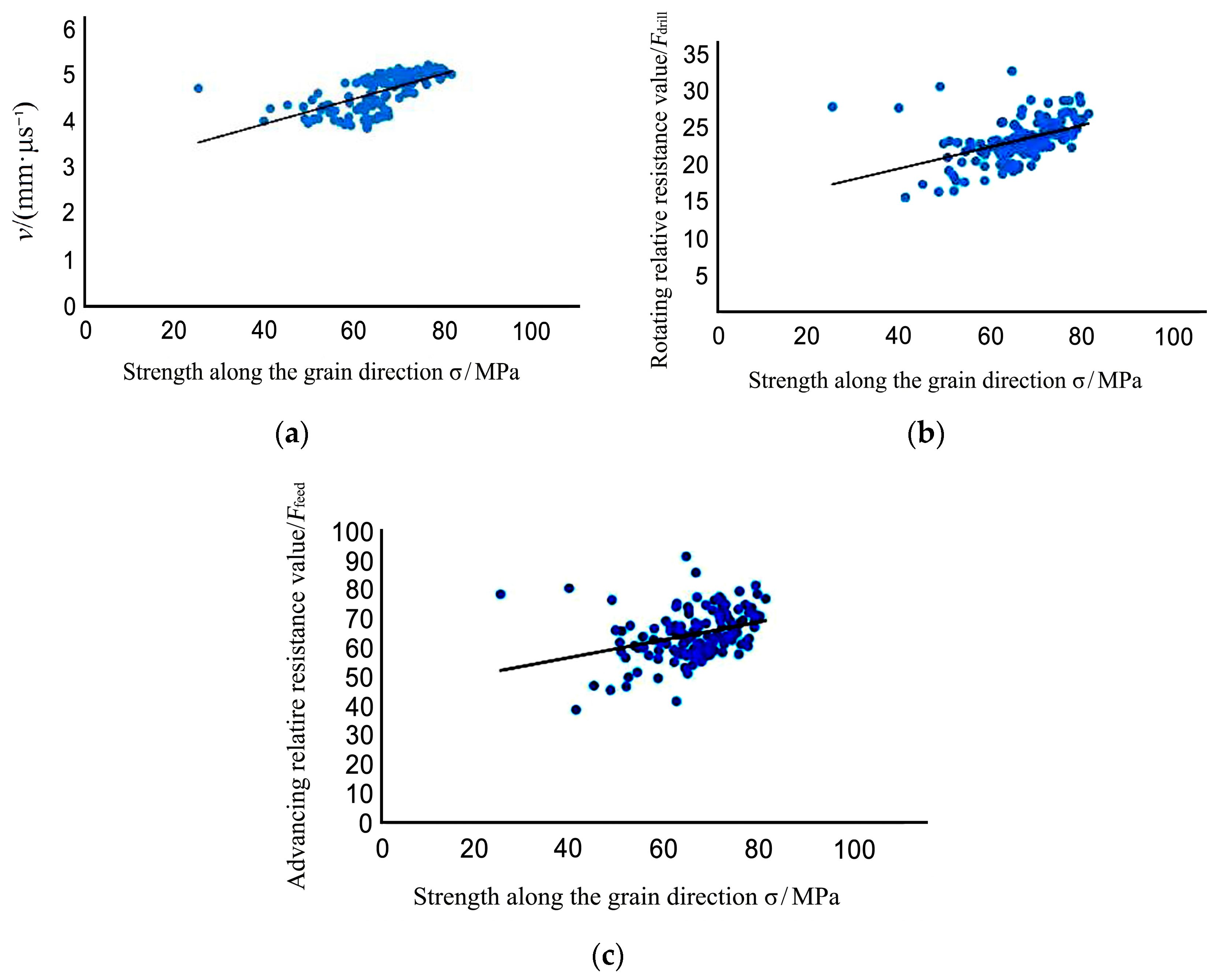
4.2. Correlation between Density and Nondestructive Testing Value
4.3. Correlation between Wave-Drag Modulus and Compressive Strength
4.4. Prediction of Compressive Bearing Capacity Modulus
4.5. Prediction of the Vulnerable Section
4.6. Prediction and Evaluation of the Residual Bearing Capacity of Timber Components
5. Conclusions
- Multi-probe stress wave detection can determine the location of the damaged interface. The impedance meter can determine the location of the internal damage by means of a single path, which can be used to screen the status of the internal material of timber components with large areas. Combined stress wave and impedance meter nondestructive testing can establish the internal defect combination model based on the Shapley method; this facilitates the location of the damaged area inside a timber component on-site.
- Through the small specimen material performance experiment, it was found that there is a low correlation between the stress wave velocity and the compressive strength. Density, as an important parameter in elastic modulus, has a relatively large correlation with the impedance meter relative resistance value. Comparison of wave-drag modulus (Fv2) and measured mechanical properties indicates that there is a significant correlation between compressive strength along the grain direction and wave-drag modulus, with higher accuracy than any single method.
- The established wave-drag modulus was verified by performing mechanical experiments on a wooden column scale model. The results show that the residual bearing capacity predicted by the model is consistent with the measured values. Simultaneously, by comparing the wave-drag modulus of different sections, the vulnerable section can be quickly located.
- When the bottom of the wooden pillar is damaged, there are certain differences in the damage mode due to the type, size, and location of the damage. If the damaged area is small, the external visible damage is not significant, but the internal damage can be observed by stress wave and impedance meter nondestructive testing. When damage with the same area but different heights occurs in the middle cavity, the comparison of residual bearing capacity is not significant. When the damage type is a defect in the edge material of the specimen, there is a serious imbalance in the damaged part, which leads to serious visible bending deformation on the outside of the specimen and an obvious decrease in residual bearing capacity. As the damage height increases, the residual bearing capacity also decreases significantly. Thus, the nondestructive stress wave and impedance meter testing method can identify the damage type and location and provide the basis for wood component repair and reinforcement in ancient buildings.
Author Contributions
Funding
Institutional Review Board Statement
Informed Consent Statement
Data Availability Statement
Conflicts of Interest
References
- Xu, J.-H.; Wang, C.; Zhang, B. Review and prospect analysis of conservation techniques in heritage timber structures in China. China Wood Industry 2020, 34, 39–47. [Google Scholar]
- Ozdemir, T.; Temia, A.; Aydin, I. Effect of wood preservatives on surface properties of coated wood. Adv. Mater. Sci. Eng. 2015, 2015, 1–6. [Google Scholar] [CrossRef] [Green Version]
- Zhang, J.; Kamdem, D.-P.; Temiz, A. Weathering of copperamine treated wood. Appl. Surf. Sci. 2009, 256, 842–846. [Google Scholar] [CrossRef]
- Zhang, X.-C.; Hu, C.-M.; Wu, C.-W.; Ma, H.-D.; Han, Y.-N. Analysis of anti-collapse performance of ancient timber frame buildings of grand style with Dou-gong under horizontal earthquake. Sci. Conserv. Archaeolgy 2020, 32, 11–18. [Google Scholar]
- Mislav, S.; Vlatka, R.; Jure, B. Inspection and condition assessment of existing timber structures. Građevinar 2017, 9, 861–873. [Google Scholar]
- Wang, M.-Q.; Wang, K.; Xu, Q.-F. Research Progress of Nondestructive Testing Technology of Timber Structure. Constr. Technol. 2019, 48, 85–89. [Google Scholar] [CrossRef]
- Liu, Y.-F.; Li, Z.-R.; Zhang, X.-L.; Teng, Q.-C.; Yao, Z.-Y. Applications of Ultrasonic Nondestructive Testing Technique in Ancient Building Testing: Take The Lintels of The Main Hall of Ancestor’s Monastery of The Shaolin Temple as an Example. Ind. Constr. 2021, 51, 37–43. [Google Scholar]
- Chen, L.; Fu, Y.-H.; Ju, F.-L.; Dai, S.-B. Non-destructive and Micro-destructive Testing Technology for Status Monitoring of Song Dynasty Wooden Columns in the Main Hall of Baoguo Temple, Ningbo. Herit. Archit. 2018, 5, 78–85. [Google Scholar] [CrossRef]
- Zhang, D.; Yu, Y.; Guan, C.; Wang, H.; Zhang, H.-J. Nondestructive testing of defect condition of wall wood columns in Yangxin Hall of the Palace Museum. Beijing. J. Beijing For. 2021, 43, 127–139. [Google Scholar] [CrossRef]
- Zhang, J.; Liao, J.-N.; Xu, Q.-F.; Zhang, M. Research on residual bearing capacity of post-beam timber frame after exposure to fire using non-destructive testing. China Civ. Eng. J. 2017, 50, 45–56. [Google Scholar] [CrossRef]
- Wang, W.-B.; Zhou, H.-B.; Dai, W. Determination of Bearing Capacity of Timber Components in Ancient Architecture. World Antiq. 2018, 2, 75–78. [Google Scholar]
- Ding, X.-Y.; Tao, X.-Y.; Diao, S.; Luan, Q.-F.; Jiang, J.-M. Estimation of wood basic density in a Pinus elliottii stand using Pilodyn and Resistograph measurements. J. Nanjing For. Univ. 2020, 44, 142–148. [Google Scholar]
- Irena, F.; Tomas, F.; Harry, X.-W. Non-destructive wood density assessment of Scots pine (Pinus sylvestris L.) using Resistograph and Pilodyn. PLoS ONE 2018, 13, 1–16. [Google Scholar] [CrossRef]
- Zhu, Y.-M. Experimental and Nondestructive Examination Studies on the Material Mechanical Properties of Chinese Fir Structural Timber. Master’s Thesis, Beijing Jiaotong University, Beijing, China, 2018. [Google Scholar]
- Wang, M.-Q.; Chen, X.; Li, Y.-S.; Wang, L.; Wang, Z.-L.; Xu, Q.-F. Case Analysis of Non-destructive Detection for Timber Structure of Existing Buildings. Constr. Technol. 2020, 49, 67–70. [Google Scholar]
- Zhang, Y.-X.; Wang, Y.; Zhang, G.-J.; Guan, Z.-Z. Application of stress wave and resistograph techniques in the wood structure inspection of ancient buildings. Earthq. Resist. Eng. Retrofit. 2019, 41, 145–157. [Google Scholar]
- Dai, J.; Chang, L.-H.; Qian, W.; Chang, H. A Study on the Non-Destructive Method of Testing Internal and External Defects of Wooden Components of Historical Buildings. Archit. J. 2017, 2, 7–10. [Google Scholar]
- Li, Z.Y.; Li, H.-K.; Wang, X.-L. Hakka ancient buildings rule component Modeling method based on building bethod. J. Fujian Norm. Univ. 2020, 36, 93–102. [Google Scholar]
- Zhu, Y.-C.; Lin, L. The modular system and implicit module in Yingzao Fashi. Archit. J. 2015, 4, 35–37. [Google Scholar]
- Zhao, F.; Wang, C.; Chen, R.-X.; Zhang, B.-J. Study of the material and workmanship of the middle hall mural at Longju temple, Guanghan. Sci. Conserv. Archaeol. 2020, 32, 8–15. [Google Scholar]
- Xu, Q.-F.; Han, C.-Q.; Chen, L.-Z.; Wang, Z.-C.; Leng, Y.-B. Experimental research on mechanical behavior of round timber columns protected with traditional craftwork after fire. China Civ. Eng. J. 2019, 52, 90–99. [Google Scholar]
- Kar, A. Axiomatization of the Shapley value on minimum cost spanning tree games. Games Econ. Behav. 2002, 38, 265–277. [Google Scholar] [CrossRef]
- Bahinipati, B.-K.; Kanda, A.; Deshmukh, S.-G. Revenue sharing in semiconductor industry supply chain: Cooperative game theoretic approach. Sadhana 2009, 34, 501–527. [Google Scholar] [CrossRef] [Green Version]
- Method of Testing in Bending Strength of Wood. National Standard of the People’s Republic of China; GB/T 1936.1-2009; General Administration of Quality Supervision, Inspection and Quarantine of the People’s Republic of China, China National Standardization Administration Committee: Beijing, China, 2009.
- Method of Testing in Compressive Strength Parallel to Grain of Wood; GB/T 1935-2009; General Administration of Quality Supervision, Inspection and Quarantine of the People’s Republic of China, China National Standardization Administration Committee: Beijing, China, 2009.
- Xu, M.-G.; Qiu, H.-X. Experimental study on properties of aged wood of ancient architecture. Earthq. Resist. Eng. Retrofit. 2011, 33, 53–55. [Google Scholar]
- Chen, W.; Zeng, H.-M.; Gao, Y.-H.; Zhao, T.-T.; Zhou, Y.-P.; Hao, Q.-Y. Analysis on the influence factors of stress wave propagation velocity of casuarina equisetifolia and two kinds of acacia standing trees. J. Hainan Norm. Univ. 2019, 32, 282–287. [Google Scholar]
- Technical Standard for Maintenance and Reinforcement of Timber Structures of Ancient Buildings. National Standard of the People’s Republic of China; GB/T50165-2020; Ministry of Housing and Urban-Rural Development of the People’s Republic of China, State Administration for Market Regulation: Beijing, China, 2020.
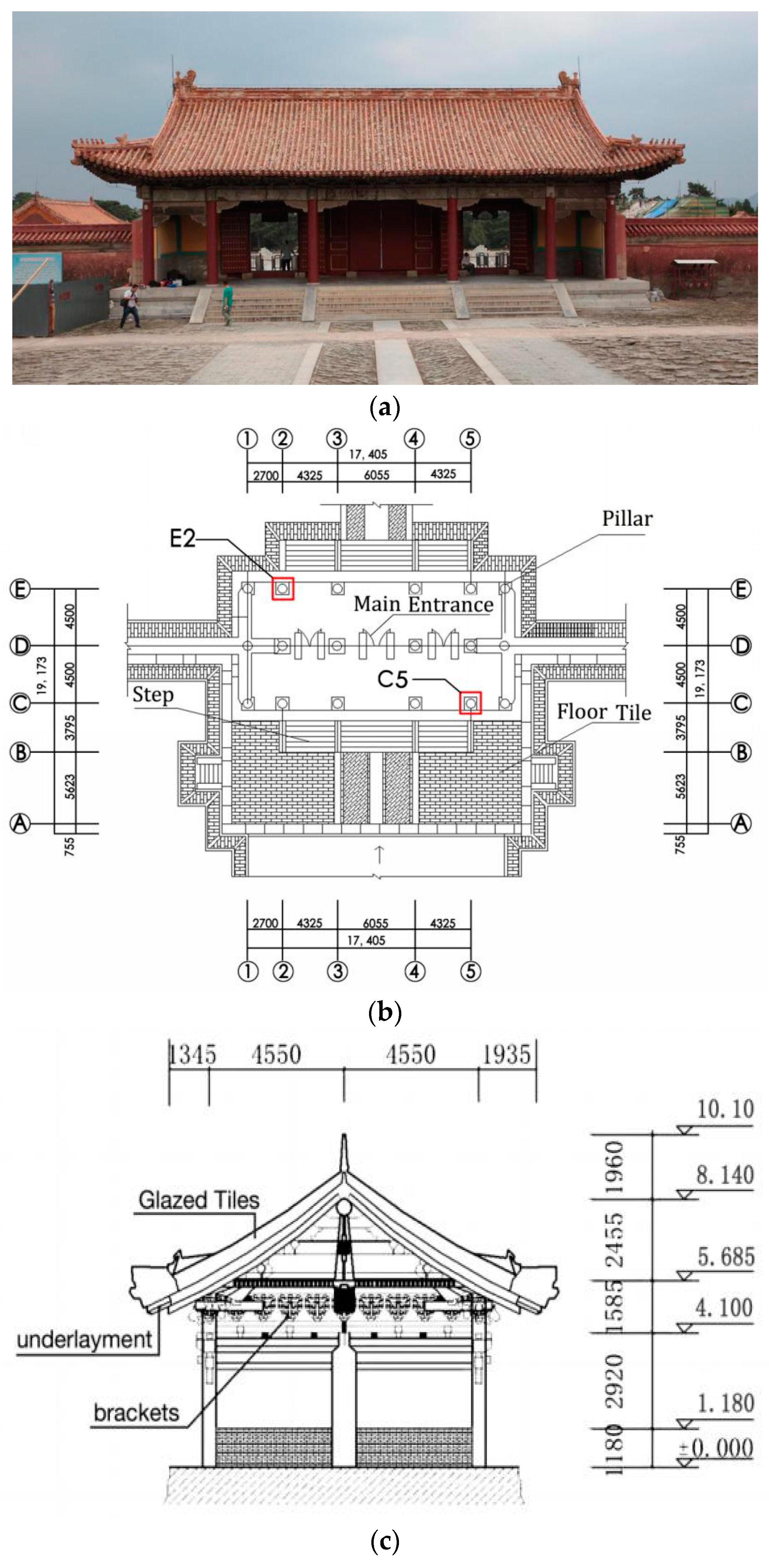
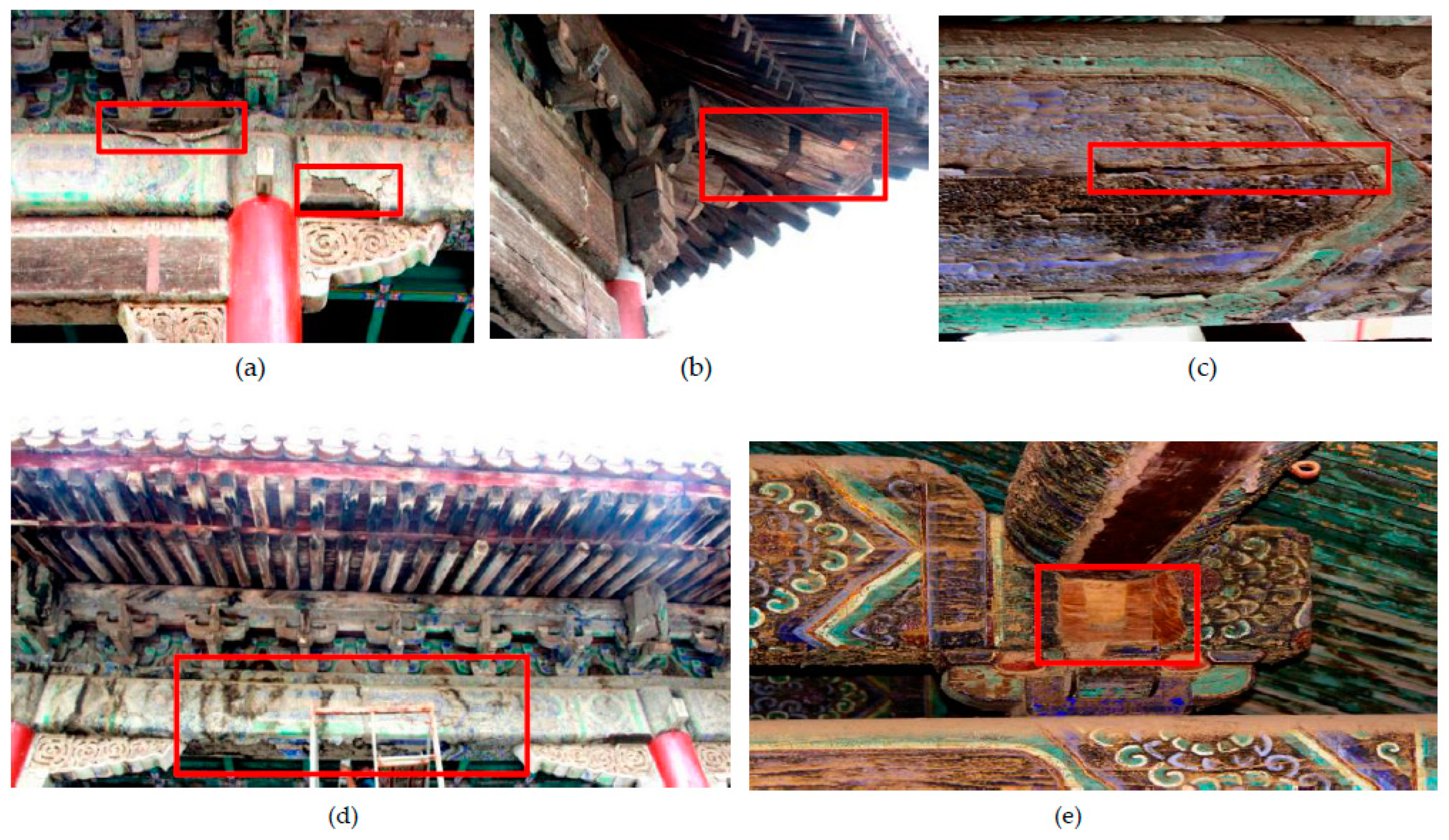


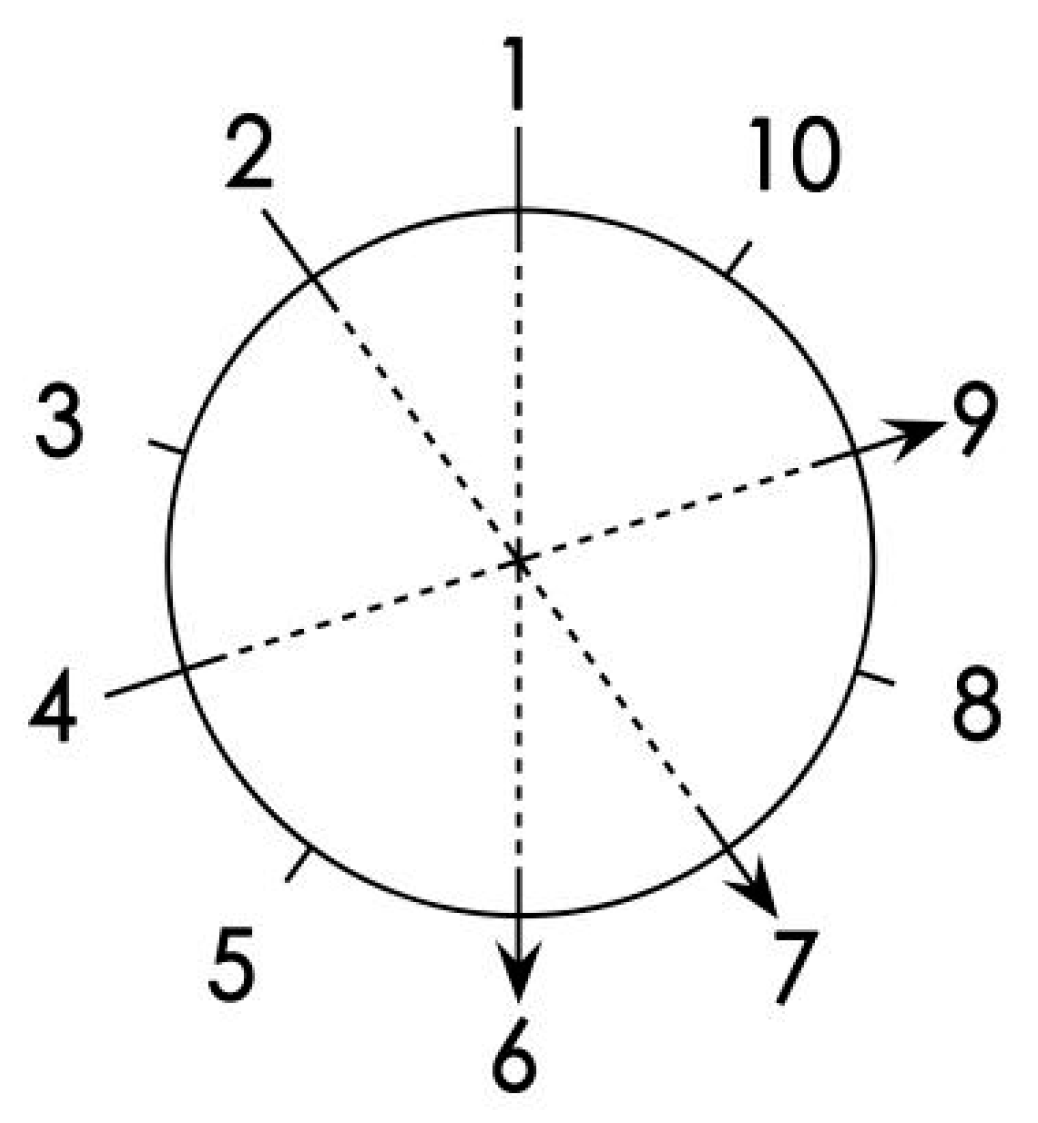
 Represents the position and length of defects in the path under relative resistance.
Represents the position and length of defects in the path under relative resistance.
 Represents the position and length of defects in the path under relative resistance.
Represents the position and length of defects in the path under relative resistance.

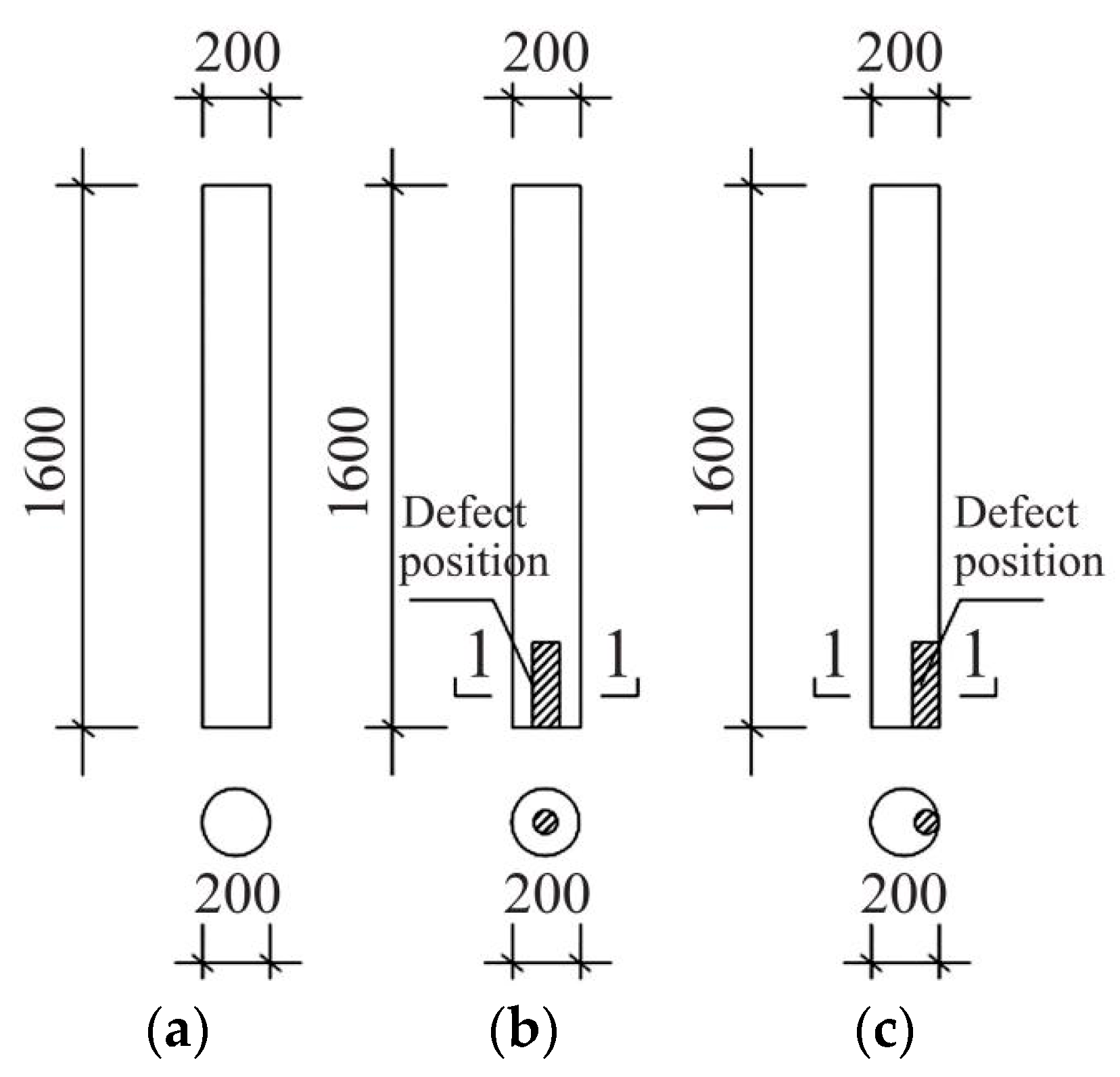
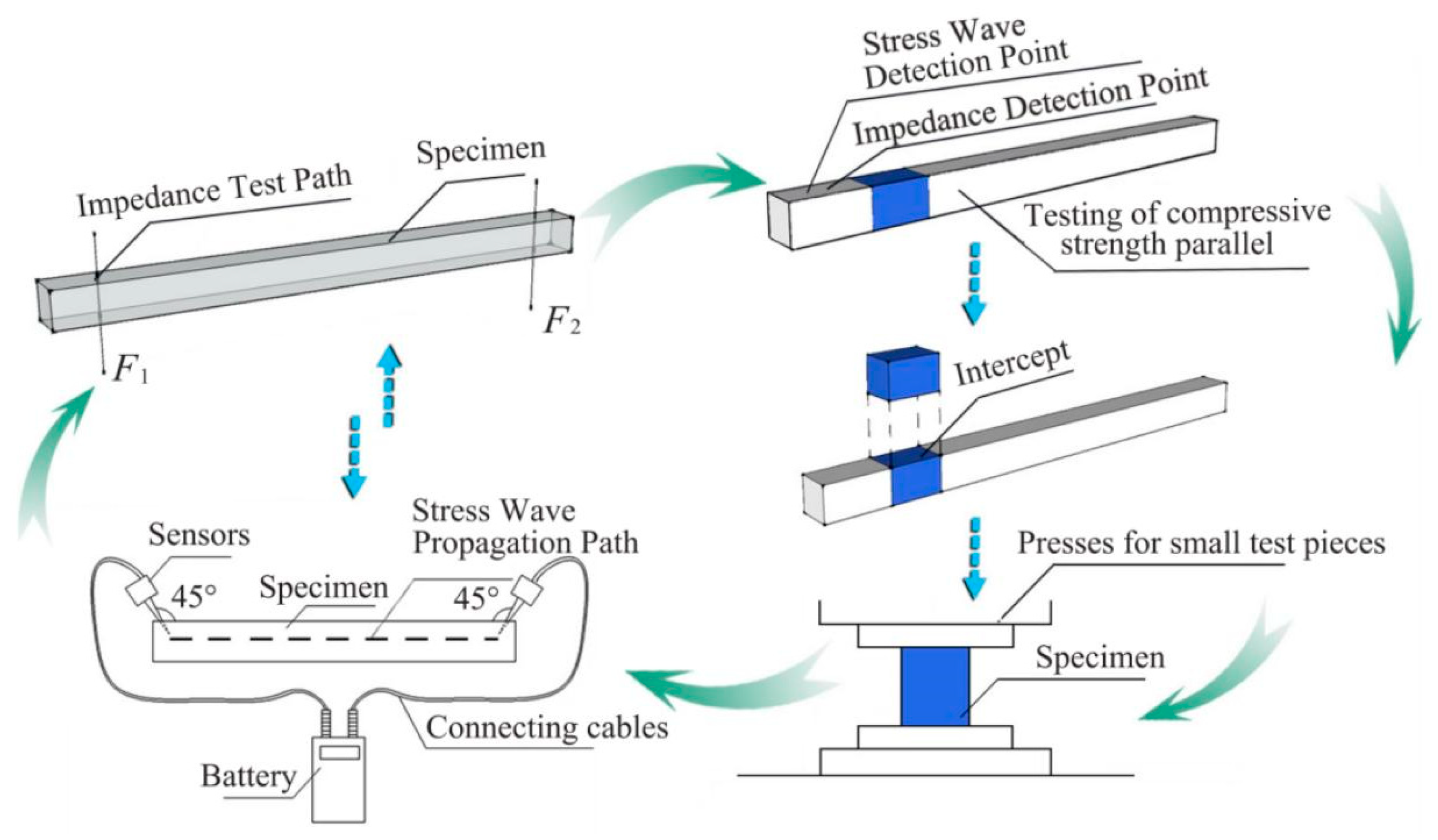

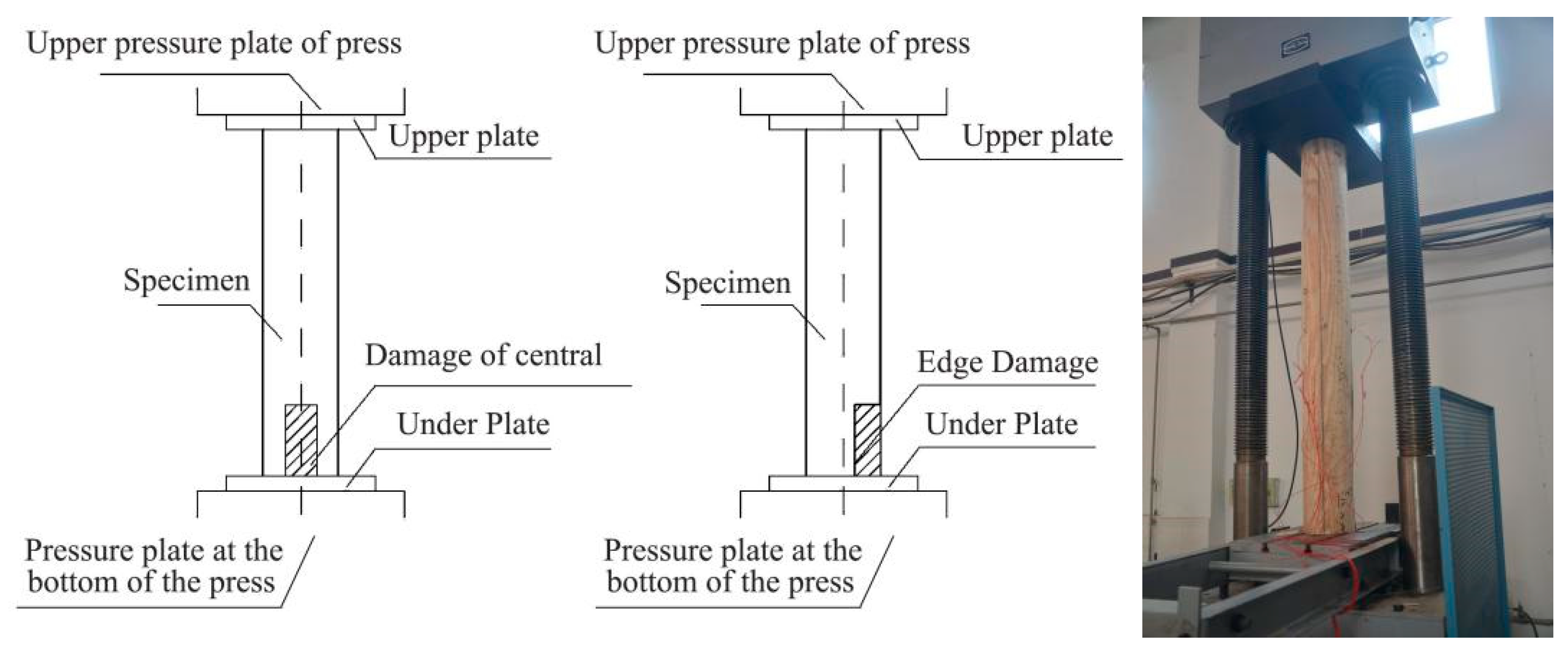

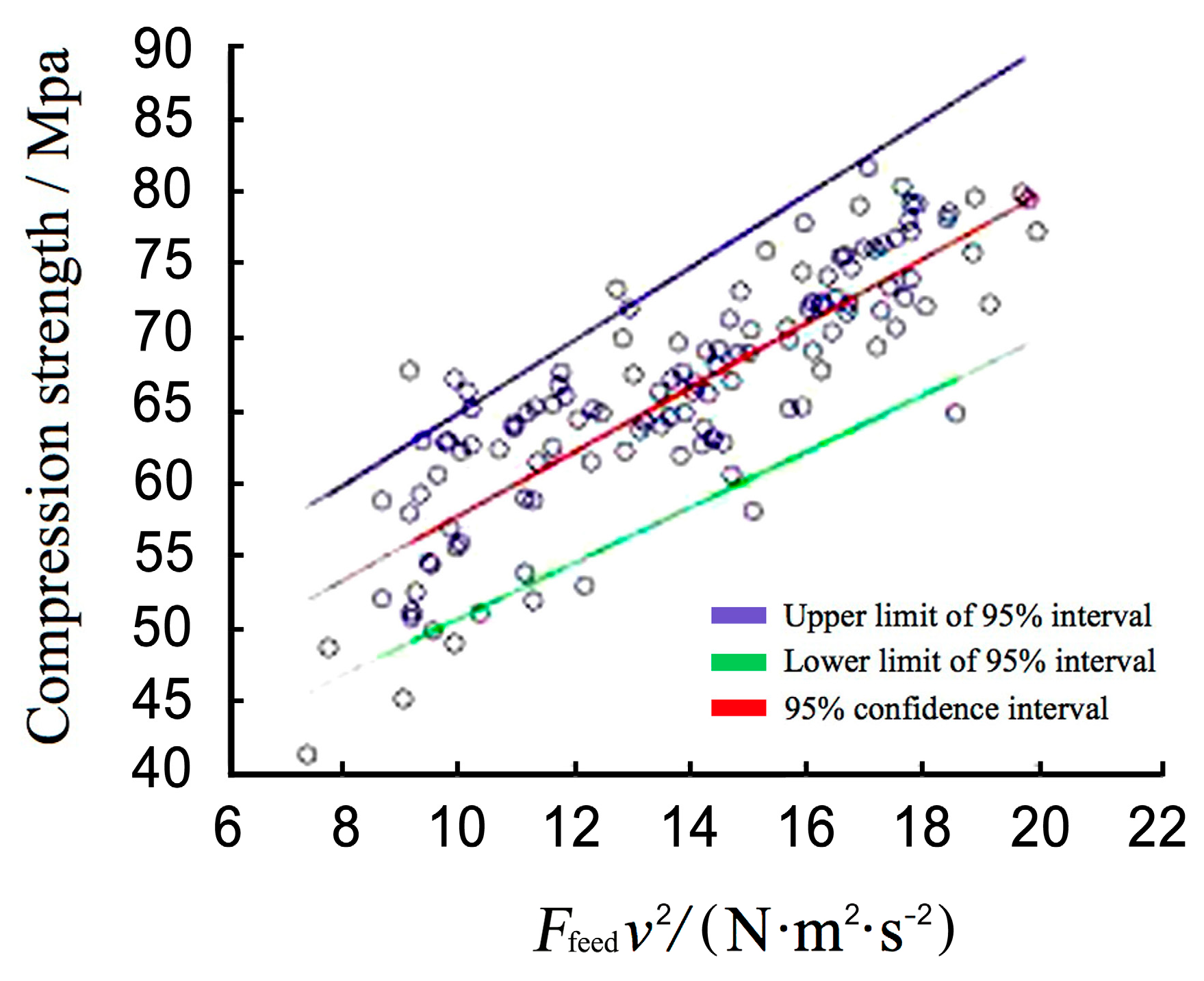
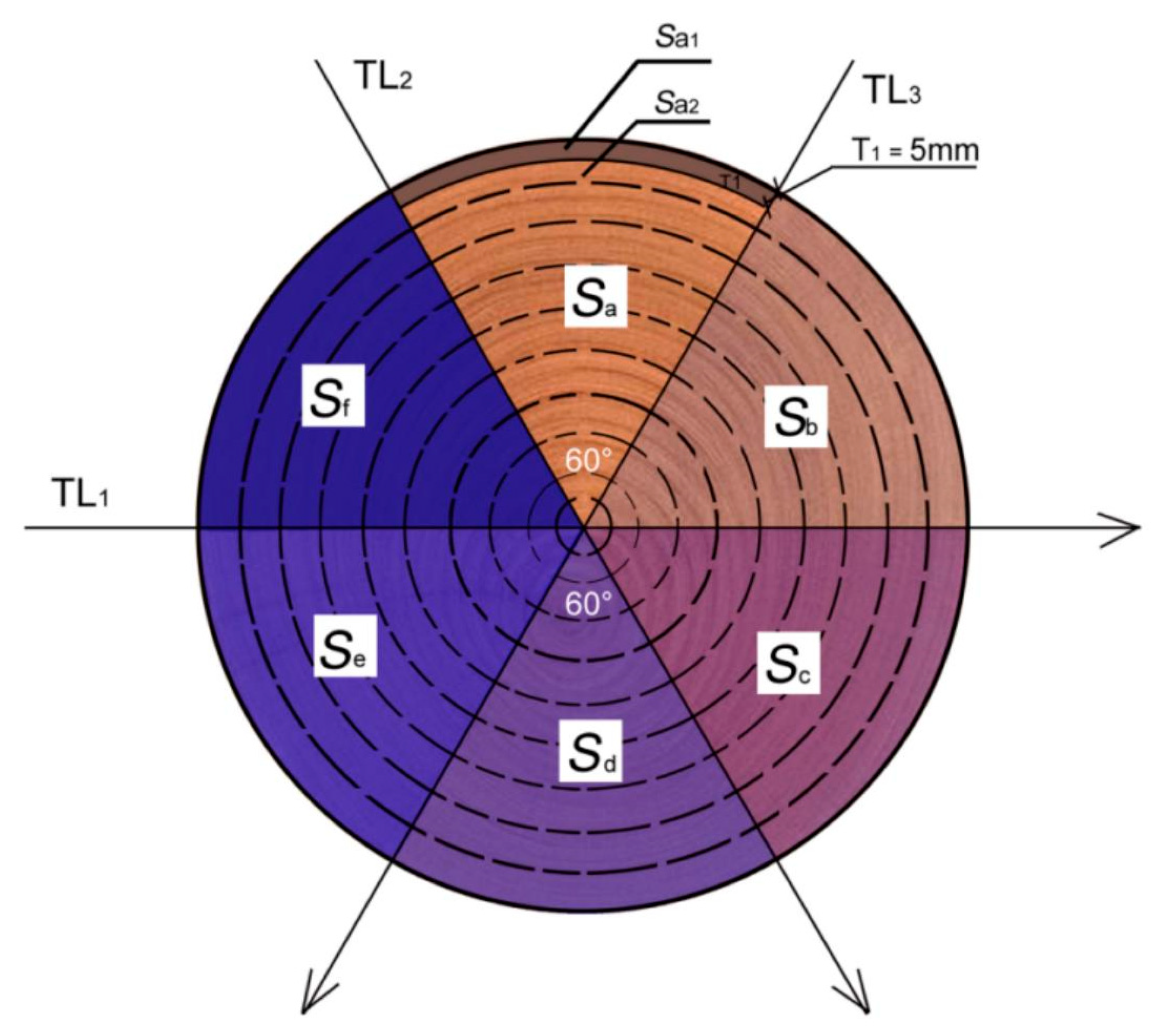
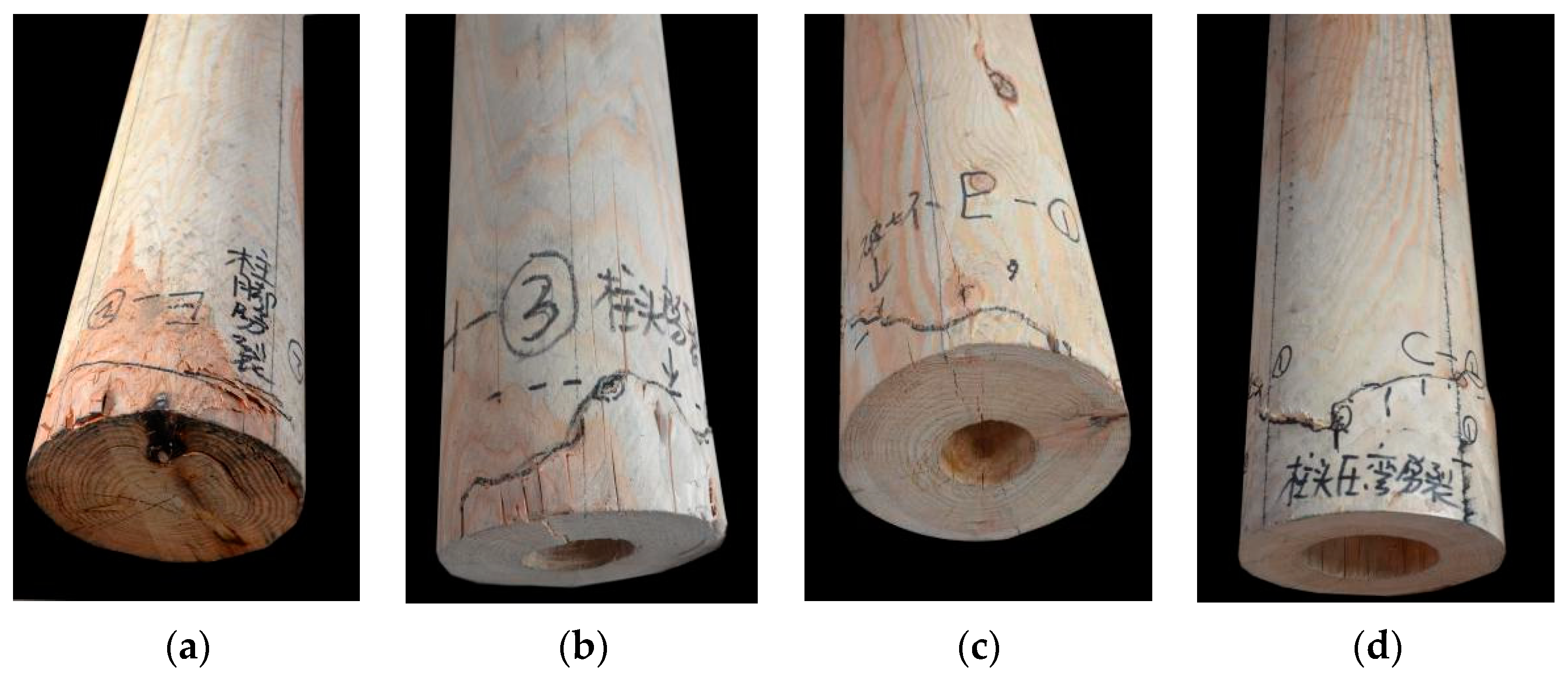
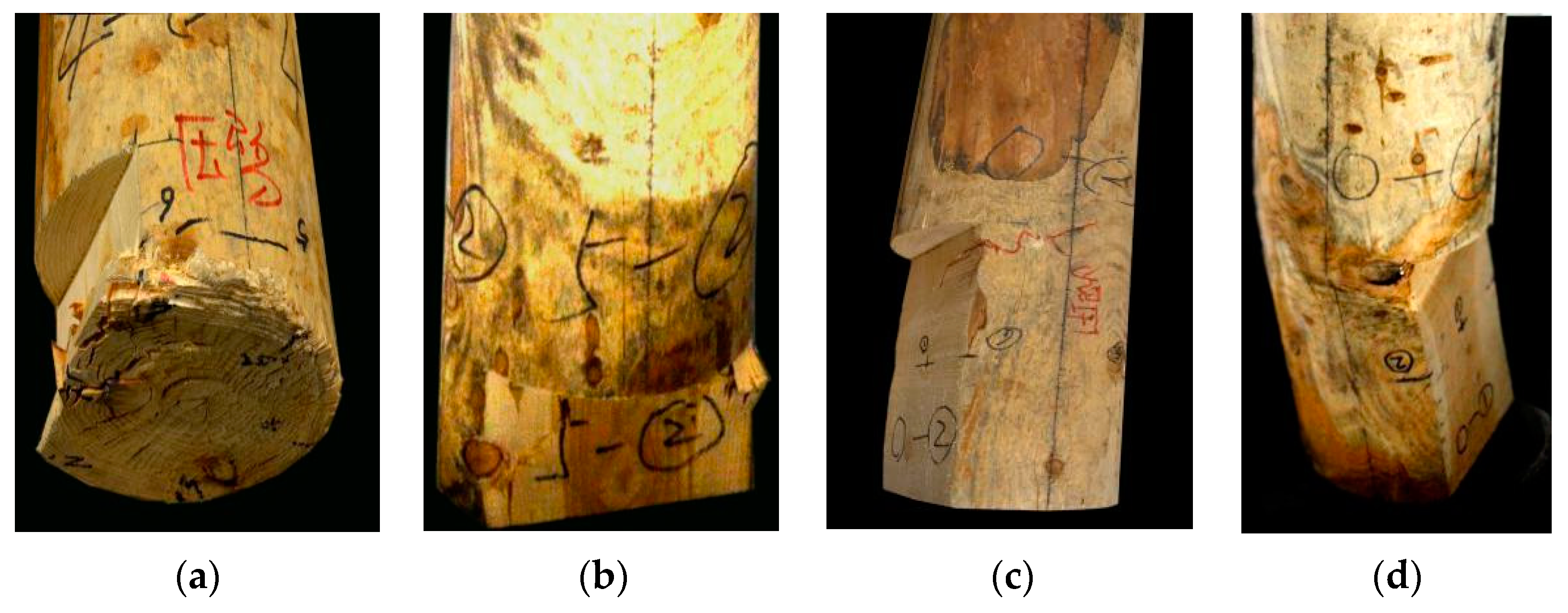
| Section Names | Height (mm) | Diameter (mm) | Type | Defective Parts | Defect Height (mm) | Defect Diameter (mm) |
|---|---|---|---|---|---|---|
| A1–A2 | 1600 | 200 | Undamaged | - | 0 | 0 |
| B1–B2 | 1600 | 200 | Core material cavity | Bottom | 100 | 64 |
| B3–B4 | 1600 | 200 | Core material cavity | Bottom | 300 | 64 |
| C1–C2 | 1600 | 200 | Edge damage | Bottom | 100 | 160 |
| C3–C4 | 1600 | 200 | Edge damage | Bottom | 300 | 160 |
| Specimen | Mechanical Test Value/kN | Nondestructive Testing Predicted Value/KN | ||||
|---|---|---|---|---|---|---|
| Test Section-I | Test Section-II | Test Section-III | Damaged Section | |||
| A1 | 893.071 | 989.36 | 989.364 | 973.353 | 973.353 | 8.99 |
| A2 | 901.374 | 989.360 | 989.368 | 989.363 | 989.360 | 9.76 |
| B1 | 705.417 | 970.742 | 954.441 | 635.153 | 635.153 | 9.96 |
| B2 | 704.705 | 971.365 | 967.671 | 639.241 | 639.241 | 9.29 |
| B3 | 596.740 | 989.369 | 989.360 | 639.113 | 639.113 | 7.10 |
| B4 | 676.541 | 980.356 | 983.561 | 634.38 | 634.387 | 6.23 |
| C1 | 616.995 | 923.571 | 975.763 | 568.057 | 568.057 | 7.93 |
| C2 | 650.008 | 967.679 | 973.351 | 563.672 | 563.672 | 13.28 |
| C3 | 477.374 | 978.643 | 981.387 | 501.321 | 501.321 | 5.02 |
| C4 | 401.442 | 972.632 | 975.474 | 457.486 | 457.486 | 13.96 |
Publisher’s Note: MDPI stays neutral with regard to jurisdictional claims in published maps and institutional affiliations. |
© 2021 by the authors. Licensee MDPI, Basel, Switzerland. This article is an open access article distributed under the terms and conditions of the Creative Commons Attribution (CC BY) license (https://creativecommons.org/licenses/by/4.0/).
Share and Cite
Chang, L.; Qian, W.; Chang, H.; Chang, X.; Ye, T. Nondestructive Testing Based Compressive Bearing Capacity Prediction Method for Damaged Wood Components of Ancient Timber Buildings. Materials 2021, 14, 5512. https://doi.org/10.3390/ma14195512
Chang L, Qian W, Chang H, Chang X, Ye T. Nondestructive Testing Based Compressive Bearing Capacity Prediction Method for Damaged Wood Components of Ancient Timber Buildings. Materials. 2021; 14(19):5512. https://doi.org/10.3390/ma14195512
Chicago/Turabian StyleChang, Lihong, Wei Qian, Hao Chang, Xiaohong Chang, and Taoping Ye. 2021. "Nondestructive Testing Based Compressive Bearing Capacity Prediction Method for Damaged Wood Components of Ancient Timber Buildings" Materials 14, no. 19: 5512. https://doi.org/10.3390/ma14195512
APA StyleChang, L., Qian, W., Chang, H., Chang, X., & Ye, T. (2021). Nondestructive Testing Based Compressive Bearing Capacity Prediction Method for Damaged Wood Components of Ancient Timber Buildings. Materials, 14(19), 5512. https://doi.org/10.3390/ma14195512





